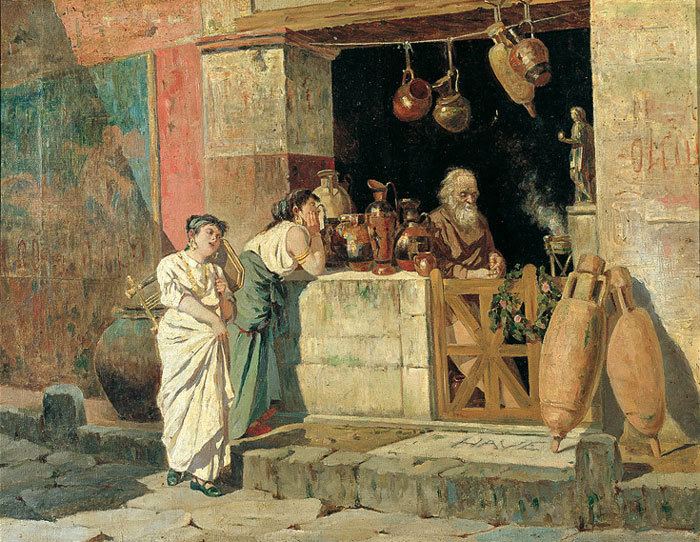Name Enrico Salfi | ||
 | ||
Died January 14, 1935, Cosenza, Italy | ||
Enrico Salfi (Cosenza, Calabria, 1857 – January 14, 1935) was an Italian painter, mainly of biblical or Ancient Roman (Pompeian) subjects. He also excelled in oil portraits.
Biography
In 1876, Salfi began his studies at the Royal Institute of Fine Arts of Naples, where he was a pupil of Salvo Pennino, and other teachers, including Angelo Mazzia, Raffaele Postiglione, and Vincenzo Marinelli. Like Morelli, but also Giuseppe Sciuti and Cesare Maccari, he had a predilection for Pompeian or Neopompeian scenes.
He lived in Naples until the 1890s, and then moved back to Cosenza. At the 1883 Promotrice of Naples he exhibited Peter the anguilla, (pompeian scene); in 1883 in Rome, he displayed two Pompeian scenes titled: Amphora Salesman and ...Licet?, the last acquired by the Provincial Council of Naples. In Turin, he exhibited : Le Maghe (Sorceresses) and at the 1985 Naples Promotrice, a Golgotha. In 1887 in Rome, he exhibited a Pompeian nights. Two other notable works are a Madonna and a Face of Jesus.
He painted an altarpiece for the church of Basilicata, depicting San Francesco di Paola in ecstasy. At the Exposizione permanente at the island of Capri started and promoted by sig. Morgano, he displayed a Effect of Lights.
In Cosenza, he painted an Allegory of the Arts (1905) on the ceiling of the Teatro Massimo (frescoes destroyed during bombardment in World War 2). He painted a large canvas depicting Sons of Brutus for the City Council of Cosenza. He published a small volume of poetry, titled Lirica Pompeiana and served in roles in his province as for example, an Inspector of Monuments and Excavations (1897-1903).
He also painted extensively for churches in Calabria, including San Domenico in Cerisano, the parish church of Parenti in Calabria, the church of San Pietro in Rogliano, and the ceiling of the church of San Nicola di Bari in Cosenza (demolished 1961). Among other works are Satan Vanquished (Exhibited in Genoa, 1904); Judas (Exhibited in International Exhibition of Fine Arts, Rome, 1911); Waiting for the wife (Biennali d'Arte Calabrese, 1922); and the somewhat hallucinatory Cantico dei Cantici” [1] (Biennale Reggina, 1926). At the Sixth exhibition of Art and Artistry of Reggio Calabria in 1931, he depicted the antisemitic legendary image of the Wandering Jew (“L’ebreo errante”).
